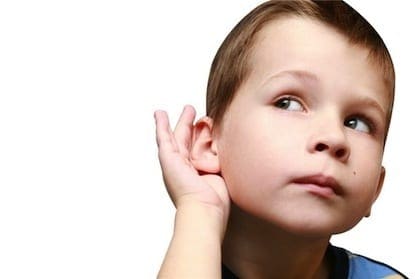Mindful Listening


A great way to introduce children to the practice of mindfulness is mindful listening. For many kids (and adults), focusing their attention on sounds is a bit easier than bringing their attention to the breath. It’s more concrete — and it can be a bit more fun!
There are LOTS of ways you can practice this with kids! Read on for my favorite mindful listening lessons:
1. Listen to the bell
You can use a traditional mindfulness bell (a singing bowl), a chime, or an app that has bell sounds. You can say the following to the kids:
“In just a moment, we are going to close our eyes and listen to the sound of the bell. So let’s sit comfortably and let our bodies be really still. When you hear the bell, try to focus on the sound, and see if you can listen to it until the sound fades away completely. When you can’t hear it any more (and we’ll have to be really quiet and still to hear it that long!), open your eyes.”
Ring the bell…
Sometimes it’s helpful to do the steps above one more time.
After a few times of listening to the bell, you can have a short discussion about mindful listening:
- Was it easy or hard to be quiet and listen to one sound?
- Did you find that you got distracted while listening to the bell?
- What other sounds could you hear besides the bell?
- How did it feel in your body to be still and listen to sounds?
Sometimes kids will say it was easy; sometimes they will say it was hard. They may say they felt calm, or bored, or restless. There is no “right” answer, and a big part of mindfulness is welcoming ALL of our experiences. With any responses children give, you can ask, “Did anyone else feel that way?”or, if it’s just you and your child, “Why do you think you felt that way?” You can also share what the experience was like for you.
This is really about helping children understand their experiences, and what it’s like to pay attention to just one thing (or at least to TRY!) Each time we bring our attention to something and keep it there (whether it’s sound or the breath), we are strengthening the attention circuits of the brain — this is mental training!
2. So many sounds around us!
You can do mindful listening even without the bell! Just close your eyes, and listen to what you can hear.You can ask children to identify five different sounds that they notice in the room.
You could extend this activity into a discussion about how our minds work:
- When you hear a sound, do you start thinking about which sounds you like and which ones you don’t? Why do you think our minds do that?
- When you hear a sound, does it sometimes make you start thinking about something else (a memory, for example)?
- Do you normally notice these sounds when you are in this room? If not, why do you think you don’t notice them?
3. The sounds of silence
One of the powerful things we discover with mindful listening is that even “silence” isn’t silent! You can help children grasp this in the lovely book Silence by Lemniscates. The book encourages children to notice the sound of snow, of leaves, of flowers, and lots of other things we don’t often think we can “hear.” It’s a short and whimsical book that’s great for preschoolers and elementary age kids.
4. Stop, children, what’s that sound?
Make mindful listening into a game with this fun activity from Yogainmyschool.com — the game is Easter-themed, but you could adapt it to any season.
For a guided meditation on mindful listening for kids, check out the video below from Mindscapes:
5. Mindful listening in the classroom
If you are a teacher, or work with large groups of kids, you may find the following resources and lesson plans helpful:
- A Ten Step Guide to Mindful Listening from MindSpace
- Starter Lesson: Mindful Bodies and Mindful Listeningfrom Mindful Schools
- Mindful Listening from MindUp
The beautiful thing about mindfulness is that there are so many different ways we can practice, and ultimately they are all about paying attention: to our breath or our thoughts, to the movements of our body, to sensations, to sounds, or to the many other elements in our field of awareness. Mindful listening strengthens our ability to pay attention, and it brings us completely into the present moment, for we can only listen NOW.
Happy listening!
Thank you, Sarah Rudell Beach.



